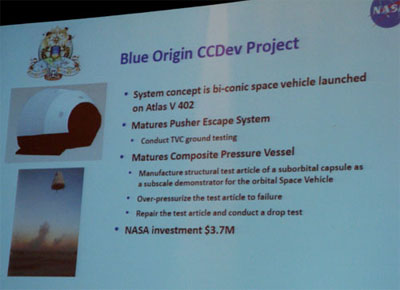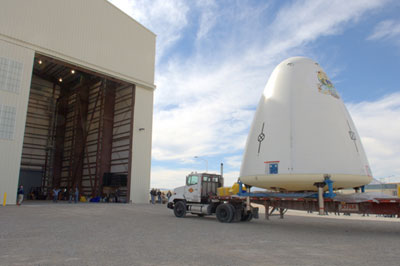Blue is a little less blackby Jeff Foust
|
| “If we’re famous for anything it’s famous for being quiet,” said Blue Origin’s Gary Lai. |
The space industry has its share of mysteries as well. In recent years people have tried to figure out what Burt Rutan and Scaled Composites were up to in the development first of SpaceShipOne, and more recently of SpaceShipTwo. For several years exactly what Bigelow Aerospace was up to in its secretive Las Vegas facilities was a mystery as well. Both companies are at least a little more open today, the former most likely because of the influence of its partner in its suborbital vehicle development work, Virgin Galactic, and the latter after flying two prototype inflatable spacecraft and drumming up business for its full-scale orbital facilities.
Both, though, arguably pale in confidentiality to another NewSpace venture, Blue Origin. The venture, established and funded by Amazon.com billionaire founder Jeff Bezos, has quietly been working for the last several years on a suborbital reusable launch vehicle called New Shepard that takes off and lands vertically. The emphasis is on “quietly”: the company has made hardly any public announcements and appearances, the biggest of which was a letter by Bezos in early January 2007 announcing the first test flight of a New Shepard prototype called Goddard that took place the preceding November. The company has also since released some information about research flight opportunities, and, late last year, selected three experiments to fly during future New Shepard test flights. But that’s about it.
The company is based in the Seattle suburb of Kent, where it has a 22,700-square-meter (244,000-square-foot) facility that is closed to the public. Those who have been there, though, describe a remarkable set of offices and work space equipped with everything from state-of-the-art equipment to space memorabilia. “I joke with people that if you want to see what a billionaire’s clubhouse looks like, go visit Blue Origin,” said Dan Rasky of NASA Ames, who visited Blue Origin as part of work by the agency to develop a commercial RLV technology roadmap.
In recent weeks, though, a little more information about Blue Origin has come out from both the company and NASA, which awarded the company a $3.7-million contract under its Commercial Crew Development (CCDev) program early this month. The new insights don’t provide much in the way of new details about the company, but for a venture as reserved as Blue Origin, every little bit helps.
At last week’s Next-Generation Suborbital Researchers Conference (NSRC) in Boulder, Colorado, Gary Lai provided an update on the company’s work. Lai noted that this was, to his knowledge, the first time a Blue Origin employee has presented at a conference. “If we’re famous for anything it’s famous for being quiet,” he said.
That silence is part of the core company philosophy, Lai explained. “We have a culture within the company to talk publicly only about results and not about plans,” an approach not unlike that of Rutan and Scaled Composites. “We measure public results by flight milestones, so when those are hit we plan to discuss the program in great detail.”
So why talk about New Shepard now? “We see great potential in the research and education market, possibly greater than space tourism itself,” Lai said. (See “Building up a new market for suborbital spaceflight”, The Space Review, December 7, 2009) “Also, we recognize that unlike space tourism, the research and education market is something that actually needs to be built up.”
| Don’t read too much into Blue Origin’s prototype, Goddard. “That is not necessarily what the operational New Shepard vehicle looks like,” Lai said. |
Lai talked about some details relevant to the research market, including the types of accommodations for payloads, interfaces, power, and other specifics. He was less forthcoming, though, about more general information about the vehicle. He did note that New Shepard would be capable of launching “three or more” people to an altitude of at least 325,000 feet (99,000 meters). The vehicle will consist of a propulsion module and a crew capsule that will launch vertically and separate after the boost phase; both will land vertically, although he said they were preserving the option to land the two modules together.
Goddard, the gumdrop-shaped prototype that flew in late 2006 and 2007 at Blue Origin’s secluded test facility in Culberson County in west Texas, may not offer clues on what the full-fledged New Shepard will be like, he cautioned. “That is not necessarily what the operational New Shepard vehicle looks like,” he said. Goddard was useful, though, in testing out operations of a VTVL rocket. “One of the main reasons for flying Goddard was to learn how to take a vertical-landing vehicle that uses the same propellants that our operational vehicle uses and learn how to fly that and turn it around in a very rapid manner,” he said. “Most of our lessons learned were in the operational area.”
Lai declined to discuss Blue Origin’s schedule or flight test plans. However, in its research opportunity materials, the company states that flight test opportunities could be available as soon as 2011 for “autonomous or remotely-controlled experiments on an uncrewed flight test”; crewed flight opportunities would follow in 2012. At a presentation later at the NSRC, Steven Collicott of Purdue University, one of three researchers selected to fly experiments on the early test phase of New Shepard, said he would be delivering his experiment to the company in November of this year.
More interesting, though, are insights into the company that have come out of its CCDev award. The contract covers work on two items: work on a “pusher” launch escape system and a composite pressure vessel. The escape system would use thrusters below a crew cabin that pushes the cabin away from its launcher in the event of a malfunction, instead of the “tractor” escape systems mounted on top of a crew capsule that pulls it away; the company had been planning something like that for its New Shepard vehicle. A composite pressure vessel would, most likely, provide a lighter-weight option for any sort of vehicle that Blue Origin might be developing.
Robert Millman of Blue Origin, who was present at the February 2 NASA press conference in Washington where NASA unveiled the CCDev winners, as well as existing COTS/CRS awardees Orbital Sciences and SpaceX, didn’t provide many details about what the company’s plans were. “The [Blue Origin] team is dedicated to creating technologies for an enduring human presence in space,” he said before briefly describing the technologies funded under their CCDev award.
| “The [Blue Origin] team is dedicated to creating technologies for an enduring human presence in space,” Millman said |
CCDev, though, is focused primarily on developing technologies that can be used for future commercial orbital vehicles, and it appears that Blue Origin is looking beyond its suborbital New Shepard vehicle. Speaking the FAA Commercial Space Transportation Conference in Washington earlier this month, Alan Lindenmoyer, who manages NASA’s Commercial Crew and Cargo Programs, presented slides describing all five CCDev awards, including one for Blue Origin. The Blue Origin slide revealed that the company was proposing a “bi-conic space vehicle” that could be launched on an Atlas 5 402, a variant of the Atlas 5 with two Centaur engines in its upper stage and no strap-on solid rocket boosters. The slide notes that the composite pressure vessel that would be tested under the CCDev contract would be structural test article of their planned suborbital vehicle “as a subscale demonstrator for the orbital Space Vehicle”.
 A slide describing the details of Blue Origin’s CCDev award presented at the FAA Commercial Space Transportation Conference earlier this month. (credit: J. Foust) |
In very brief comments after the February 2 press conference, Millman said that Blue Origin was still focused on its suborbital program right now, proceeding “step by step”. He didn’t provide any specifics, such as schedule, about the company’s development of New Shepard or any future orbital vehicle, other than to say that flight tests are “coming up”.
So Blue Origin still retains most of its secrets, and what it has revealed may do little more than sustain and enhance interest in what the company may offer in the next few years as one of several entrants in the suborbital, and possibly orbital, commercial human spaceflight field. One day, perhaps, it will all become clear what the company has been up to the last several years, just as eventually you find out what’s in those presents under the tree. (Figuring out the mysteries of Lost, though? Good luck with that.)
